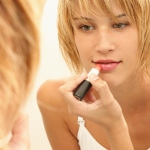Health assessment of Cosmetics

Products which come into contact with human skin must be non-hazardous to health. The BfR assesses the risks of ingredients in cosmetic products - from lipstick to tooth bleaching agents - with the support of the Cosmetics Committee.
Skin cream, toothpaste, shampoo - cosmetics not only include decorative cosmetics such as lipstick or make-up but also all substances and preparations which are exclusively or predominantly intended to be applied externally to the body or in the oral cavity. This also includes suntan lotions, soap and other personal care products. Their common feature is that they are used for cleaning, keeping the skin and body in good condition, as perfumes and scents or to change a person's appearance. For the BfR, ensuring that cosmetic products are safe for consumers to use takes top priority.
Approval and notification
Cosmetics are not subject to approval. Certain ingredients like preservatives, colorants or UV filters have to be approved.
Producers of cosmetics must guarantee that their products do not pose any risk based on safety assessments.
The European Commission operates an internet portal via which cosmetic products have to be notified before they are marketed. Among other things, manufacturers are obliged to enter the formula of their product so that the poison centres can access the details in the course of their advisory work. Information on nano-sized ingredients must also be entered.
The Federal Office of Consumer Protection and Food Safety provides more information on the notification process at www.bvl.bund.de/EN.
Where necessary, the BfR assesses the ingredients of cosmetics with regard to their health safety.
Advisory role
The BfR advises the Federal Ministry for the Environment, Nature Conservation, Nuclear Safety and Consumer Protection (BMUV) on the health risk assessment of cosmetics.
Legal bases
- German Food and Feed Code (LFGB)
- German Product Safety Act (ProdSG)
- Regulation (EC) No. 1223/2009
Opinion
25
Tattoo inks: minimum requirements and test methods (1,012.56 KB)
Tattoo inks: risk assessment for Pigment Blue 15:3 and Pigment Green 7 (199.57 KB)
Skin creams, make-up and shampoos should be free from Pluralibacter (194.40 KB)
Reducing aluminium intake can minimise potential health risks (174.27 KB)
Highly refined mineral oils in cosmetics: Health risks are not to be expected according to current knowledge (167.58 KB)
Aluminium-containing antiperspirants contribute to aluminium intake (158.74 KB)
Hair colouring products: self-tests can cause allergies (46.60 KB)
Infection Risks through Tattooing (30.26 KB)
Vitamin A: Intake via cosmetic products should be restricted (30.97 KB)
Polyethylene-containing microplastic particles: health risk resulting from the use of skin cleansing and dental care products is unlikely (31.83 KB)
β-Arbutin in skin lighteners is a health risk (26.36 KB)
Methylisothiazolinone (MI) contained in cosmetics may cause allergies (23.56 KB)
Requirements for Tattoo Inks (125.74 KB)
Proposals for the guideline on the assessment of chemical risks in the European rapid alert system RAPEX (24.74 KB)
Liquid agents for nail modelling with high methyl methacrylate contents present a health risk (31.67 KB)
Some Tattoo Colours Contain Carcinogenic PAH (86.78 KB)
Henna hair dyes that contain p-Phenylenediamine (PPD) pose a health risk (28.18 KB)
Assessment of formaldehyde-containing hair straighteners (57.28 KB)
Sunscreen: According to the current state of knowledge zinc oxide as UV filter is safe (28.54 KB)
BfR recommends that nano-silver is not used in foods and everyday products (27.86 KB)
Requirements for the safety assessment of tattooing agents (31.63 KB)
Children's cosmetics should not contain any allergenic peanut oil (27.26 KB)
Lip care products should not contain any boric acid (27.17 KB)
Use of undiluted tea-tree oil as a cosmetic (80.31 KB)
UV-Filters in Sun Protection Products (115.10 KB)
FAQ
8
Titanium dioxide: Are there health risks? (313.24 KB)
Frequently asked questions about tattoo inks (93.59 KB)
Frequently asked questions regarding the BfR's reassessment of aluminium in antiperspirants from 20 July 2020 (59.55 KB)
Sun cream and similar products - are there health risks? (53.70 KB)
Microplastics: Facts, research and open questions (73.04 KB)
Questions and answers on the study lead of BfR investigating the distribution of tattoo ink as nano-sized particles in lymph nodes (44.40 KB)
Questions and Answers on Mineral Oil in Cosmetic Products (37.12 KB)
Questions and Answers on the Risk Assessment of Cosmetic Products (34.47 KB)
Other documents
2
Import of cosmetic products (28.88 KB)
BfR Consumer Conference on Nanotechnology in Foods, Cosmetics and Textiles (130.34 KB)
Press releases
23
-
05.08.2008
Allergies caused by inhaling fragrances?
-
24.11.2014
Aluminium in everyday life: a health risk?
-
06.10.2005
Always use enough sun protection!
-
18.07.2007
BfR repeats its warning about henna tattoos
-
10.03.2008
Consumer products - Safety despite diversity
-
01.08.2011
Risks, which get under the skin
-
07.03.2008
Safety of Consumer Products
-
04.05.2009
Tattoo inks become safer
Communication
5
Toxicological testing requirements to be developed: 3rd Expert discussion at the BfR on tattoo inks (90.27 KB)
Operable minimum toxicological requirements: 2nd Expert discussion at BfR on tattoo inks (134.90 KB)
Self-experiment: Body can absorb fluorine-containing chemical PFOA through the skin (97.60 KB)
How much aluminium passes through the skin? The BfR reviews a new expert opinion (134.07 KB)
Is there a risk to human health from microplastics? More research and scientific data needed (112.61 KB)
External Links
5
- Opinion concerning the safety of paraben usage in food (AFC, 28 September 2004)
- Opinion concerning 6-Acetyl-1,1,2,4,4,7-hexamethyltetraline (AHTN) (SCCNFP, 24 October 2000)
- Opinion concerning Hexahydro-hexamethyl-cyclopenta (g )-2-benzopyran (HHCB) (SCCNFP, 24 October 2000)
- Opinion on Safety of Tattoos (SCCNFP, 17 February 2000)
- Position Statement concerning para-Phenylenediamine and similar Substances and their use in Skin Stains (Temporary Tattoos) (SCCNFP, 13 March 2001)
